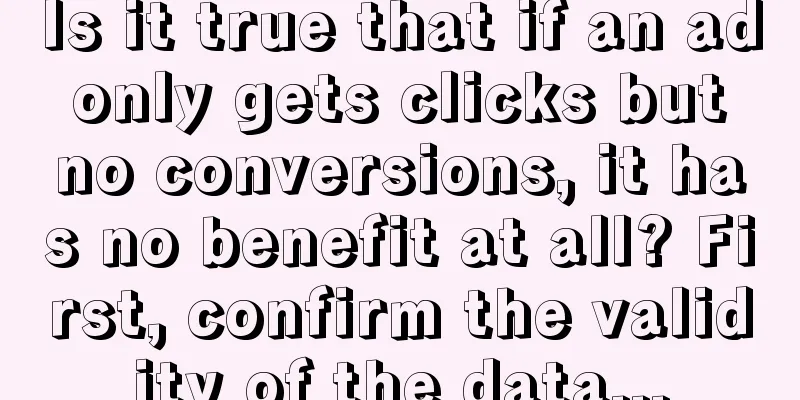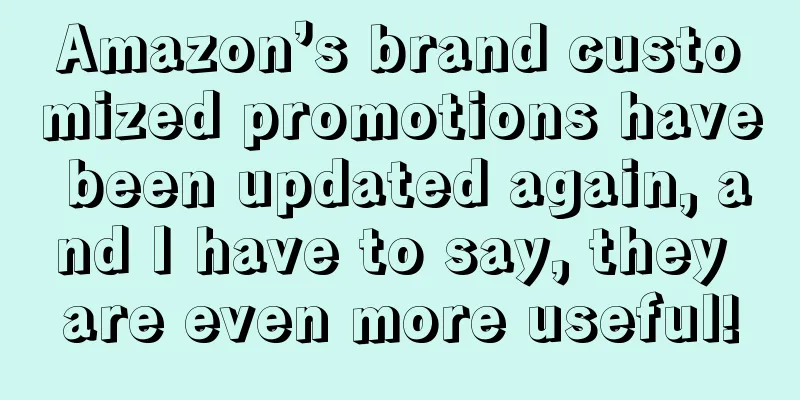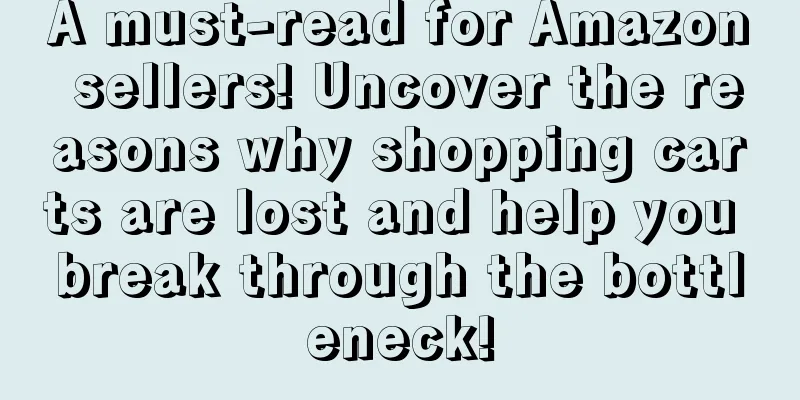|
Shiyilang and the gangster
June started with a busy work, and I showed off my crappy timi in the midst of my busy schedule. As a result, on 0-5-25, I opened the backend and saw this ad that only had clicks but no conversions. Suddenly, I wanted to break it into pieces, chew it, and swallow it.
Is it true that there is no benefit if the ad only gets clicks but no conversions? Is this normal? What can I do about it?
First, confirm the validity of the data:
1. How many clicks are there? If in a cycle, how many clicks are there per day on average? Are they enough to generate conversion conditions? If the number of clicks is too small, or there are many clicks in a certain cycle, but the average number of clicks per day cannot meet the conversion conditions, then it is not very useful. This includes data that is concentrated on a certain day with many clicks, and the ads are frequently adjusted.
2. How long is the advertising data? Is there enough time for Amazon to determine invalid clicks or intentional clicks by peers?
3. When is the advertising budget distributed? If the budget itself is insufficient and not properly managed, the budget will be spent during the non-optimal ordering time period of the day.
Under the assumption that the above problem is normal, this problem corresponds to two traffic types:
1. General traffic ad group: automatic/broad/category/phrase
2. Precision traffic advertising group: precision/ASIN fixed investment
If it is a precision advertising group: the product has multiple variants, whether there are too many clicks under a certain ASIN, if it is concentrated, consider changing the ASIN, if it is not concentrated, consider the ad position, if the ad position is concentrated, try to change the position, if it is not concentrated, then consider who has taken my head
Analysis logic:
1. The advertisement is accurate and there is no problem of improper traffic
2. If you can click in, the main picture, price review, there should be no problem/or the front-end placement is not bad
3. Customers click in but do not make a purchase, which does not meet their expectations
So check the link details page to see if there are competitors with lower prices, better ratings, and bigger brands, especially under the shopping cart, under the five points, and batch export the competitor ASIN analysis under the details page
If there are no competitive opponents, you need to consider the basic link situation. I will not go into details about how to optimize and where to optimize. Let's listen to the analysis next time. If it doesn't work, first meet the requirements of reaching 100%.
Analysis of general traffic types
The advertisement itself is a general traffic attribute, so you should carefully analyze whether the customer's search terms are accurate. It is not recommended to judge by looking at the Chinese meaning after translation. It is more recommended to search at the front desk to see the relevance of the products actually searched. Don't feel it. If it is off, consider whether there are types of advertisements that are easy to go off, such as super-large words that are broad and have no pre-negation, such as automatically opening related matches at the same time. If there are none of them, but the traffic is very general, you need to consider link copy optimization issues
General traffic type, customer search terms, whether there is concentration, if concentrated with a certain search term, how well does the term match? If there is no concentrated keyword, all the terms are very general, and each is clicked 1-2 times, then for this search term, the order is accidental
Analyze the issues of ASIN and advertising space, same as above
Here is just a brief analysis of the logic, but generally there are only clicks but no conversions on ads. The situations I encountered are basically:
1. Early stage of new product
2. After adjusting the ad (any adjustment is considered an adjustment, including CPC, negative words, switches, bids, etc.)
3. Make adjustments to the link
4. Link abnormality
5. Malicious clicks by opponents
If there are only clicks but no conversions, is it really true that there is no benefit at all?
Under normal circumstances, under a certain keyword, clicking on a product is conducive to the improvement of the product's natural ranking under the keyword, but if it has not been converted for a long time, the advertisement will gradually become worse and worse, and finally no data can be run out. Therefore, when there is traffic coming in, what I need to do is to promote conversion, but link polishing seems to be more important than advertising.
Sometimes when there is a problem, you don’t have to optimize the link immediately. Changing the link too frequently is not a good thing. However, there are still many people who optimize the link when they encounter a problem.
Of course, if there are clicks but no conversions, it is not limited to the above basic analysis, including product styles, our so-called differentiation, whether it is recognized by the market? If it is just a problem with a certain keyword, is it not suitable to place this word in this time period? Sometimes, do nothing and restart, and sometimes the data will gradually improve.
It's late at night
I don't know what I wrote
I will polish and optimize it when I have time to rest next time.
We are all salted fish, why can others turn things around? I guess it’s because I didn’t “keep going”
Administrator Arong • Shenzhen • 6 days ago Zhiwubuyan Community held the 2024 Amazon Productivity Conference in Bao'an, Shenzhen on June 28, and invited Mr. Shiyilang as a guest to share more and more comprehensive advertising knowledge with everyone! Click the link to sign up now: https://www.hudongba.com/dis/0zv30dvywr
Communicate “face to face” with Senior Shiyilang!
"Wonderful Reply"
Stupid kid First of all, I need to correct one thing. Except for pure red ocean categories like Sanbao, advertising is just icing on the cake!
The so-called icing on the cake means making greater increments on the basis of a very stable and high-quality basic link base, rather than not optimizing the links to the extreme and simply relying on advertising to boost rankings?
Furthermore, Amazon is no longer in the era of growth, but is basically in a game of existing market share. Therefore, whether it is the transaction price of competitors or the CPC of advertisements, they have actually skyrocketed. This is also an inevitable stage in the development of the platform.
Finally, if your ad has a high click-through rate but low conversion rate, check yourself from two dimensions:
1. It is very important that the advertisements must be exposed in the right location and the right category. In the past, some people have exposed most of the products in Category A in Category B.
2. In theory, you should check your own product details page (price, number of reviews, star rating, copywriting, pictures, A+, competitor ad space on the page, etc.) one by one. When you eliminate all variables, you will get the answer to the constant! G leeson • Guangdong • 17 hours ago @笨孩子的呀: I agree with some of them. Now the homogeneity is serious. Most sellers are involuntarily competing with each other. Everyone’s links are basically perfect. Now we have to rely on advertising to grab some traffic. If the advertising is done well, the advantages are much greater.
Anonymous user Let me first state the conclusion: Clicks without conversions are useful for new products. (Old products are another story)
1. How many clicks are there? If so, how many clicks are there per day on average in a cycle? Are they sufficient to generate conversions?
The number of clicks can be controlled by the CPC and budget of the advertisement. The number of clicks required can be inferred based on the conversion rate of the category or the conversion rate of the keyword, and then the corresponding bid and budget can be given. Then the CPC can be adjusted and the budget can be increased based on the number of clicks required within the cycle.
Points to discuss: Can the current CPC have exposure and clicks? Where is the click position? (Homepage top, other positions on the homepage, product details). Is there a conversion for the click?
It is highly likely that the clicks generated by the current CPC bid are on the product page. If the number of clicks is sufficient but there is still no conversion, for automatic advertising, check whether the clicked words or products are relevant. If so, consider adjusting the bid to other positions on the homepage and wait a few more days with a big coupon. The same is true for precision advertising. Adjust the bid to the homepage position + big coupons, and basically there will be conversions.
After the conversion, we need to consider the conversion rate. Normally, if the click-through rate and conversion rate are higher than those of competitors, there will be a steady stream of natural traffic coming in. Whether you can capture it and form a cycle depends on the product and subsequent operational capabilities.
What if there is conversion, but the conversion rate is not up to standard? Find ways to improve the conversion rate, look at the factors that affect the conversion rate (price, discount, comments, details page, etc.), and observe the effect while optimizing. Within a certain period of time, if the effect is good, continue to promote it, and if the effect is not good, consider whether to clear the stock.
2. How long is the advertising data? Is there enough time for Amazon to determine invalid clicks or intentional clicks by peers?
Automatic generally runs for at least 2 weeks to see the budget and clicks before making adjustments. If the data correlation is very high, it will run for a month before making adjustments. Manual mainly looks at the number of clicks and conversion rate of keywords. If the conversion rate meets the standard, no adjustment is made in the early stage, only the budget is increased. If the conversion rate does not meet the standard, adjust the ad position appropriately and then see the conversion rate.
Automatic and manual methods usually take 7 days to accumulate data or remove invalid clicks. Unless it is an obvious prank by a competitor, you don’t need to deliberately judge invalid clicks. Just look at the trend of the advertising data, whether the orders are increasing and the conversion rate is rising.
3. Over what time period is the advertising budget distributed?
If the budget itself is insufficient and not properly managed, the budget will be used up during the non-optimal order-issuing time period of the day. There is no need to deliberately control the time period. If the budget is sufficient, let it run throughout the entire time period.
Shadowdaker -Going to work means having time to think Agree from: Yi is Xiao Bai, Jessie90418, kopper, Holshet Many people only look at surface data when they watch advertisements, such as CVR, CTR, CPC, Impression, etc.
From experience, in addition to these surface data, there are also some platform sales logic behind them.
For example, a product or a new product has no sales at first, and then it starts advertising. However, the conversion rate is very poor in the early stage. But then you will find that natural orders start to come in.
In my words, the core of advertising is to drive listings, allowing listings to match platform algorithms, generate natural traffic, and then generate natural orders. After all, if a product wants to be successful, it still depends on natural traffic.
So the issue you asked about clicks not converting is actually just a relatively preliminary level.
I am Xinyue - Xinyue is an old service provider Agree with: Morven, Gezelligheid, Cross-border Bricklayer, wanfenhaoyi, blackmelody more » Is the purpose of running an ad to quickly locate and match the listing, verify the keywords in the listing, and see if the direction is correct? The conversion of early ads is definitely not very good, and there may even be a situation where no orders are generated from ad clicks, but there are organic orders. At this time, the ad cannot be moved and should be allowed to continue. Our goal is to generate organic orders. Ads and listings are a process of mutual verification, and both need to be optimized slowly. Is my idea correct? Please advise. Drizzle wets the light • Asia Pacific • 4 days ago Wrong! Keywords still need to be tested for accuracy through advertising. Do I understand that the work of collecting, sorting and testing keywords is being done in a mess?
Sunset Roller Coaster • Meizhou • 4 days ago Most of the words we collected in the early stage were reverse search of competitors. Some words may have high conversion rates for competitors, but low conversion rates for us, so we need advertising data to verify it.
I am Xinyue • Hong Kong • 1 day ago @落日飞车: If the conversion rate of our competitor's keywords is low and the advertising data is not good, then where should we expand our keywords?
I am Xinyue • Hong Kong • 1 day ago @细雨湿流光: If the ad verification word fails to convert, and these words are already buried in the listing, what should I do?
Duole loves to be in a daze • Shenzhen • 1 day ago My suggestion is: search the buried word in the front desk, and see if you have an advantage under this word: price, rating, page, product differentiation. If there are less than two advantages among the four, then I suggest you can bury long-tail words. Or if you still want to bury this word, then I suggest you first establish an association between your product positioning or SD advertising and your competitor's link. At this time, you should also compare your link with the competitor's link to see what the advantage will be. You may need to adjust the price, first let it be clicked under the competitor's link and generate a purchase, and then you can open a manual group advertisement to run it, which will be more effective.
Anonymous user I'd like to ask, I have a word, which has a high matching degree with the product, and the phrase has a good conversion. Basically, the word that generates orders is the word itself, and there are only a few long-tail words. More orders are generated on the product page, and the ACOS is also the lowest. However, starting from June, the conversion has been poor, just like before, basically all clicks are on the product page, but the conversion is poor, the ACOS is off the charts, and the click-through rate is similar to before, or even a little higher than before. Recently, I have only adjusted the budget and cpc, and the single words are normal, but some completely irrelevant words have been rejected. The listing has not been adjusted, the link is normal, and there are no bad reviews. How to troubleshoot this situation? Small Amazon Operations • Shenzhen • 5 days ago If the click-through rate is not a problem, I suggest you check whether the price and listing of your competitor's ASIN are better than yours. In this case, it is very likely that the customer clicked in, but your listing is worse than the competitor in some aspects, and he hijacked your order on the detail page. Another suggestion is to check whether the market for your product is rising or falling recently. The impact of out-of-stock is also relatively large. These are what I can think of for now, and you are welcome to add to it.
Hakulamata69 • Deyang • 2 days ago @小小小Amazon操作: Hello, I have a similar situation to the above person. I have a question. Will low inventory but no out-of-stock affect conversion? What I can see directly at the front desk is that the delivery time is 1-2 days longer than other competing products, and even 2-3 days longer in some zip codes.
Small Amazon Operations • Shenzhen • 2 days ago @哈库拉马塔塔69 : Delivery time will affect your conversion rate, it is also part of your link. Unless your product and listing are much better than your competitors, and now Amazon has started to charge lower inventory fees.
Oh My Worn-Out Boots • Quanzhou • 1 day ago Maybe a competitor is coming up? Search to see what products are showing up, compare them with your own products and optimize them
Youfeng666 • Shenzhen • 23 hours ago Check whether there are strong competitors on your page, whether the top sellers are promoting products, and whether your previous data accumulation is insufficient, which may affect the accuracy of the data.
Duan Jiejie My personal opinion is that advertising is used to put listings in front of buyers to place orders. With clicks and orders, there will be natural traffic. To leverage natural traffic, you need to give it some time to see if it can be stabilized. If it can be stabilized, and the natural traffic is stable, you can reduce advertising.
If the ranking drops after some ads are removed, it is likely that the product has no advantages or the selling point is unclear. Reverse optimization of the listing is necessary. If multiple optimizations have no effect, it is recommended to abandon the product. If some ads are removed and the ranking is stable, then increase the number of ads. Reduce the original advertising investment and increase new traffic in turn.
Like advertising space, or bidding. If the product is not competitive enough, there will be a great need for advertising operations. If the competitiveness is sufficient, advertising is just an introduction, and a little natural traffic will be enough.
This is just my humble opinion, and everyone is welcome to discuss the errors.
angena720 If the ad only gets clicks but no conversions, it needs to be viewed in stages. The initial stage of a new product - the system initially refers to data such as exposure and clicks to verify the matching degree between keywords and the audience.
Under the conditions of intermediate and late-stage precise delivery, if your ads are only clicked for a long time without conversions, the platform will determine that you are not competitive and cannot generate benefits, resulting in lower and lower ad weights.
Oh my worn out boots Agree from: wanfenhaoyi You can run a report to count the hot spot order times, and make sure that the ads for the time periods you frequently purchase are running. Of course, if you have sufficient funds, it is best to have ads displayed at all times, which is more conducive to stabilizing the ad position.
|










